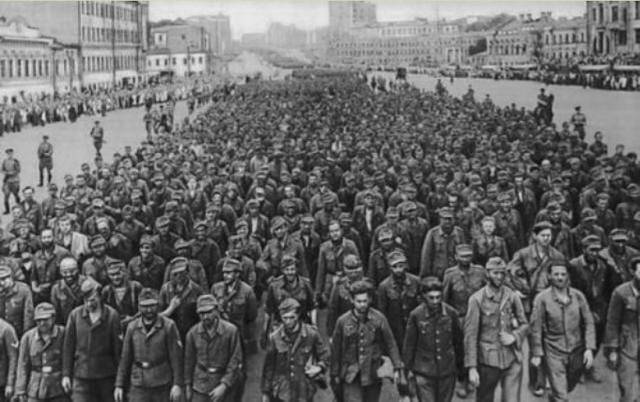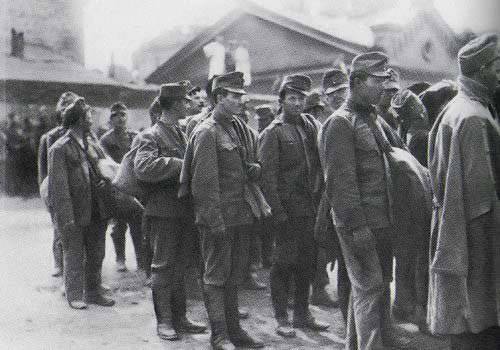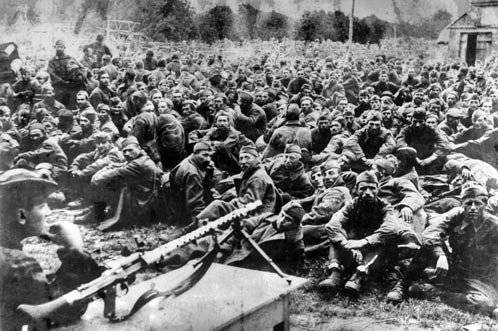POWs of World War II

History Wars are not only the history of battles, diplomacy, victories, defeats, orders of command and feats, it is also the history of prisoners of war. The fate of Soviet prisoners of war during World War II is one of the most tragic pages of our past. Soviet prisoners of war were captured in their own land, defending this land, and prisoners of war of the Hitler coalition were captured in a foreign land, to which they came as invaders.
In captivity, you can "appear" (having been wounded, falling into an unconscious state, not having weapons and ammunition for resistance) or "surrender" - raise your hands when you can and still have something to fight. Why did the armed man who swore allegiance to his homeland stop resistance? Perhaps this is the nature of man? After all, he obeys the instinct of self-preservation, based on a sense of fear.
“Of course, at first the war was scary. And even very. What is it like a young guy to constantly see how shells are torn, bombs, mines, comrades die, they are crippled by shrapnel, bullets. But then, I noticed, no longer fear, but something else forced to bite into the ground, seek shelter, hide. I would call it a sense of self-preservation. After all, fear paralyzes the will, and a sense of self-preservation makes it necessary to look for ways out of seemingly hopeless situations ", - said the veteran of the Great Patriotic War Ivan Petrovich Spit.
In life there is a partial fear, the fear of a phenomenon. But there is absolute fear when a person is on the verge of death. And this is the most powerful enemy - it turns off thinking, does not allow soberly to perceive reality. A person loses the ability to think critically, analyze a situation, control his behavior. Having suffered a shock, you can break down as a person.
Fear is a massive disease. According to a number of experts, today 9 of millions of Germans periodically suffer from panic attacks, and more than 1 million experience it constantly. And it is in peacetime! This is how World War II responds to the psyche of those born later. Each has its own resistance to fear: in danger, one will fall into a stupor (sharp mental oppression to complete numbness), the other will panic, and the third will calmly seek a way out of this situation. In battle, under the fire of the enemy, everyone is afraid, but they act differently: some fight, and others take at least with their bare hands!
Physical condition influences behavior in battle, sometimes a person "simply cannot". Recently, healthy young men are exhausted by hunger, cold, unhealing wounds, enemy fire without the opportunity to hide ... A vivid example of this is a message from the Volkhov Front army surrounded by 2 shock army (spring 1942 of the year): "The marshes melted, neither trenches, nor dugouts, we eat young foliage, birch bark, leather parts of ammunition, small animals ... 3 weeks received 50 g of rusks ... We ate the last horses ... The last 3 days weren't eating at all ... People are extremely exhausted, there is group mortality due to hunger. " War - permanent hard labor. Soldiers dig up millions of tons of land, usually with a small deminer shovel! Slightly shifted position - dig again; a respite in combat conditions is out of the question. Does any army know about sleep on the go? And here it was commonplace on the march.

In the US Army there is an outlandish type of casualties - "overwork in battle." When disembarking in Normandy (June 1944), it was 20 percent of the total number of those who left the battlefield. In general, in the Second World War, the loss of the United States due to "overwork" amounted to 929 307 people! The Soviet soldier remained in battle formations until death or injury (there was also a change of units, but only because of large losses or considerations of tactics).
We had no war until the rest. The blow of the German military machine could withstand the only force in the world - our army! And our exhausted soldiers sleeping on the march, in need of soldiers who had eaten horses, overcame the well-equipped skillful enemy! Not only soldiers, but also generals ... For our people, who won the most terrible war in the history of mankind, freedom and independence of the Motherland turned out to be most important. For her on the front and in the rear people sacrificed themselves. They sacrificed, therefore they won.
According to various estimates, the number of Soviet soldiers in German captivity in 1941-1945. ranged from 4 559 000 to 5 735 000 people. The numbers are really huge, but there are a lot of objective reasons for such a massive capture of people. The suddenness of the attack played its role in this. In addition, it was massive: about 22 million people crossed the border with the USSR 4,6 June. War began 152 Division, Brigade and the 1 2 motorized regiment of the Wehrmacht, 16 3 Finnish divisions and brigades, 4 Hungarian team, 13 9 Rumanian divisions and brigades, Italian divisions 3, 2 1 Slovak division and brigade. Most of them had combat experience, were well equipped and armed - by that time almost all of the European industry worked for Germany.
On the eve of the war, the Wehrmacht’s General Staff reports on the state of the Red Army noted that its weakness lies in the commanders' fear of responsibility, which was caused by the pre-war purges among the troops. Stalin's opinion that it is better for a Red Army soldier to die than to be captured by the enemy was enshrined in Soviet legislation. The "Provision on military crimes" 1927 of the year established the equality of the concepts of "surrender" and "voluntary transition to the side of the enemy", which was punishable by execution with confiscation of property.
In addition, the will of the defenders was influenced by the lack of a reliable rear. Even if the Soviet fighters and commanders, in spite of everything, kept to death, in the rear they already had burning cities, which mercilessly bombed German planes. Warriors were worried about the fate of their loved ones. Flows of refugees replenished the sea of captives. The atmosphere of panic during the first weeks of the war also played into the hands of the attackers and did not allow them to soberly assess the situation and take the right decisions to fight the invaders.
The order of the People’s Commissar of Defense of the USSR No. 270 of 16 of August 1941 emphasized: “Commanders and political workers who, during a battle, tear down insignia and deserting to the rear or surrender to the enemy, are considered to be malicious deserters whose families are subject to arrest as relatives who violated the oath and betrayed deserters of their homeland ... To oblige each soldier, regardless of his official position, to demand from his superior, if part of him is surrounded, to fight to the last opportunity to break through His own, and if a boss or a part of the organization of the Red Army instead repel the enemy would prefer to surrender his prisoner - to destroy them by all means, both terrestrial and air, and the family surrendered captive Red Army to deny state benefits and help. "
With the beginning of the war, it became clear that the extermination of not only the prisoners, but also the civilian population, was taking on an ever more terrifying scale. Trying to rectify the situation, June 16 27, the People's Commissar for Foreign Affairs Vyacheslav Molotov, telegraphs the chairman of the ICRC (International Committee of the Red Cross) about the Soviet Union’s readiness to exchange lists of prisoners of war and the possibility of revising the attitude to the Hague Convention on Laws and Customs of Land Warfare. We must not forget that it was precisely with the refusal of the USSR to accede to the Geneva Convention that Hitler motivated his appeals not to apply the rules of international law to Soviet prisoners of war. A month before the invasion of the Soviet Union, the Wehrmacht High Command (RCC) prepared instructions on the treatment of the captured representatives of political power in the Red Army. One of the proposals was reduced to the need to destroy the political commissars in the front camps.
17 July 1941 of the year Vyacheslav Molotov made a special note through the embassy and the Red Cross of Sweden brought Germany and her allies to the USSR’s consent to comply with the requirements of the Hague Convention 1907 of the Year "On the laws and customs of land warfare". The document emphasized that the Soviet government would comply with the requirements of the convention with respect to fascist Germany "only to the extent that this convention will be observed by Germany itself." A Gestapo order was dated the same day that provided for the destruction of "all Soviet prisoners of war who were or could be dangerous to National Socialism."
The attitude to the prisoners in Russia has long been humane. Mercy to the vanquished was demanded by the “Council Code” of Moscow Russia (1649): “The enemy, asking for mercy, to spare; not to kill unarmed; not to fight with women; not to touch young people with prisoners, to be humanely ashamed, to be ashamed of barbarism. philanthropy. A soldier must defeat the might of an enemy, and not defeat unarmed. " And they did this for centuries.

After 1945, the 4 of a million Germans, Japanese, Hungarians, Austrians, Romanians, Italians, Finns turned out to be in our captivity ... What was the attitude towards them? They felt sorry for them. Of the captured Germans, two thirds of us survived; of ours in German camps, one third! “We were fed better in captivity than the Russians themselves ate. I left part of my heart in Russia,” testifies one of the German veterans who survived Soviet captivity and returned to their homeland, Germany. The daily ration of an ordinary prisoner of war according to the norms of the boiler allowance for prisoners of war in the NKVD camps was 600 grams of rye bread, 40 grams of meat, 120 grams of fish, 600 grams of potatoes and vegetables, other products of total energy value 2533 kcal per day.
Unfortunately, most of the provisions of the Geneva Conventions on the Treatment of Prisoners of War remained on paper. German captivity - one of the darkest phenomena of the Second World War. The picture of fascist captivity was very difficult, the atrocities did not stop throughout the war. Everyone knows what the "cultural" Germans and Japanese did during the Second World War, conducting experiments on people, mocking them in the death camps ... That's how KD wrote. Sparrows in his story "This is us, Lord! ...", about what he had to endure in fascist captivity: "Kaunas camp" G "was a quarantine transfer point. There was therefore no special" accomplishments "in it typical of standard camps. But there were SS men armed with ... iron shovels. They were already standing lined up, tiredly leaning on their “military weapons.” The camp gates behind the exhausted Major Velichko had not yet closed, as SS men with inhuman whooping crashed into the thick of the prisoners and began to kill them. Blood spattered the kami flew off the skin felled with the wrong slanting of a shovel. The camp was announced with a roar of rabid murderers, moans of the people being killed, heavy tramp of legs in fear of the people who were throwing around. ”
Or another: "The ration of food issued by the prisoners was 150 grams of moldy bread from sawdust and 425 grams of gruel per day ... In Šiauliai the largest building is a prison. In the courtyard, in the corridors, in four hundred cells, in the attic - wherever it was possible that people were sitting, standing, writhing. There were more than one thousand of them. They were not fed. The Germans had been dismantled. The dead people were killed by typhus and famine were cleaned from the first floor and from the courtyard. the number of lice. In the morning six machine gunner They drove into the prison courtyard. Three wagons filled with corpses and still breathing were taken from prison to the field. Each van dragged fifty prisoners. The place where half-corpses were dumped into a huge ditch was separated from the city four versts. Of the one hundred and fifty people carrying terrible cargo, they reached there one hundred and twenty. Eighty-ninety returned. The rest were shot on the way to the cemetery and back. "
Nevertheless, many of the captured tried to escape: in groups, alone, from the camps, during shipment. Here are data from German sources: "On 01.09.42 (for 14 months of war): 41300 Russians fled from captivity." Further more. Minister of Economics of Hitler's Germany, Speer, reports to the Führer: "The shoots became rampant: every month, out of the total number of those who fled, they are able to find and return to the places of work up to 40000 people." By 01.05.44, the city (there is still a year of war) while attempting to escape 1 killed a million prisoners of war. Our grandfathers and fathers!
In Germany and the USSR since the Second World War, relatives of the missing person were denied support (they did not pay benefits, pensions). The person who surrendered to captivity was perceived as an enemy; this was not only the position of the authorities, but also the attitude of society. Hostility, lack of sympathy and social support - all of these former prisoners faced daily. In Japan, suicide was preferred to captivity; otherwise, close relatives of the prisoner were persecuted in their homeland.
In 1944, the return of prisoners of war and repatriated prisoners to the Soviet Union increased dramatically. In the summer of this year, a new filtering and inspection system was introduced for all returnees by the state security agencies. To check the "former Red Army soldiers who were captured and surrounded by the enemy," a whole network of special camps was created. In 1942, in addition to the former Yug special camp, 22 camps were established in the Vologda, Tambov, Ryazan, Kursk, Voronezh and other areas. In practice, these special camps were high-security military prisons, and for prisoners who, overwhelmingly, did not commit any crimes.
Prisoners of war freed from special camps were reduced to special battalions and sent to remote areas of the country for permanent work at enterprises of the timber and coal industry. Only 29 June 1956 of the Central Committee of the CPSU and the USSR Council of Ministers adopted a resolution "On the elimination of the consequences of gross violations of the law in relation to former prisoners of war and their families." Since 1956, all ex-prisoners ’cases have been reviewed. The vast majority of them are rehabilitated.
Objectively, captivity is always a defeat, submission to the will of the enemy. But at the same time, this is the right of an unarmed person. Being in captivity, a warrior must rely on the protection of his rights by the state that sent him to the front. The state is obliged to adhere to one of the ancient international principles - the return of a prisoner of war to his homeland and his restoration in all the rights of a citizen. In addition, on the part of the state that captured the soldier in captivity, the norms of international law must be respected.
The following facts are interesting. In 1985, the medal "For decent service in captivity" was instituted in the USA. It is awarded to soldiers who have been in captivity, including posthumously. And on April 9, 2003, the American president announced a new state holiday - the Day of Remembrance of American Prisoners of War. Addressing this to the nation, he said: "They are national heroes, and their service in our country will not be forgotten." All this asserts in the soldiers the assurance that they will be taken care of. In the minds of American soldiers, the idea that their homeland in the war does not forget and does not blame them for anything, if they are not “lucky” in the war, is firmly entrenched. In Western countries, people think differently: "The most valuable thing in life is life itself, which is given only once. And you can do anything to save it." Expressions such as "die for one's homeland," "sacrifice oneself," "honor is worth more than life," "one cannot betray" have long been no longer a measure of a soldier and a man for them.
Information